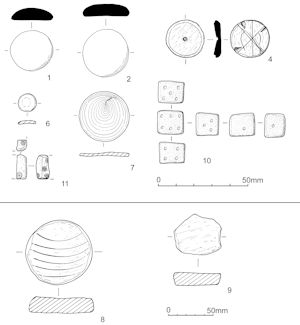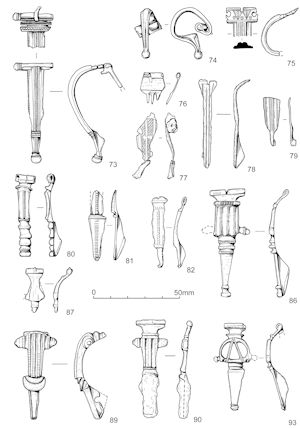
This category is poorly represented, and contains only sixteen bone and three glass counters, a number of ceramic discs that may be counters, and two dice, one made from bone, and one from lead (Table 62). Fourteen of the bone counters came from a single cremation (12203: the counters are described with the other finds from the cremation). The number of bone and glass counters is not unusually small for a site of this size and type. The use of purpose-made counters in board games is a Roman introduction, and sites in Roman towns tend to produce much larger numbers of counters than rural settlements. This may reflect a greater degree of Romanisation, or at least a more cosmopolitan milieu, in which the playing of 'foreign' games is more widespread among the population. The ceramic discs, fashioned from pot or tile sherds, have been included in this function category, although, as noted below, they are not necessarily counters.
Dice are far less common than counters, but, like counters, tend to be found in larger quantities on urban sites. Dice made in materials other than bone are extremely rare, so the lead die is an unusual find.
Another object that might belong to this category is the copper-alloy jointed figurine leg (SF5806). It could be from a doll, although surely from the Roman equivalent of the best porcelain doll, that could only be played with on Sundays.
The low number of finds in this category is unlikely to be a true reflection of the place of recreational activities in the settlement. Most of the objects that fit into this category could be made of wood - dolls, musical instruments, playing boards - and therefore have vanished from the archaeological record. The only representative may be the wooden 'sword' from well 8188, and even this could be utilitarian.

Glass counters are fairly common site finds and occur throughout the Roman period, although small counters appear to be most commonly in use during the 1st and 2nd centuries. Bone counters superseded glass examples during the later 2nd century and are thus more numerous in the later Roman period. The few counters found at Elms Farm are large examples, however, and these could be later Roman.
1. Complete, large plano-convex counter. Purple, appearing black. Upper surface scratched. Lower surface worn very smooth and slightly pitted. Diam. 22.5mm. SF6828, Fill 8737, Pit 8736, Group 902, Area P, Period 6
2. Complete, large, plano-convex counter. Opaque black. Smooth surfaces, some pitting on lower surface. Height 7mm, Diam. 26mm. SF2239, Fill 10262, Pit 10271, Group 829, Area F, Period 4
3. Not illustrated. Fragment, c. 45% large plano-convex counter. Dark appearing black. Upper surface heavily scratched and pitted. Lower surface worn smooth and scratched. Diam. 25mm. SF3555, Layer 5929, Group 3011, Area I, Period 3B
4. Crummy type 2. Complete. The upper surface is decorated with a groove 2mm in from the outer edge. The reverse has three straight inscribed lines, dividing it into six segments. Short curves have been inscribed in two of the segments, looking a little like a double-headed axe. Four notches have been roughly cut around the edge. SF6576, Fill 5939, Pit 5940, Group 420, Area J, Period 4
5. Not illustrated. Crummy type 2. The upper surface is decorated with five concentric grooves. Complete. Diam. 23mm, Th. 3mm. SF1138, Fill 7119, Pit 7118, Group 852, Area G, Period 3
Cite this as: Tyrell, R. and Major, H. 2015, Ceramic discs, in M. Atkinson and S.J. Preston Heybridge: A Late Iron Age and Roman Settlement, Excavations at Elms Farm 1993-5, Internet Archaeology 40. http://dx.doi.org/10.11141/ia.40.1.major2
The excavations produced twenty-four discs made from reused pot bases and wall sherds. Most of these are neatly trimmed into discs from the original roughly circular sherd, with three exceptions. The edges of these have been ground to a smoother finish. It is difficult to be certain whether these differences are because the discs are in different stages of manufacture, or are due to variations in quality. The discs range in size from 20-87mm in diameter, in weight from 2-127g, and in thickness from 3-17mm.
Identification of the pottery fabrics chosen for these discs reveals a wide range of pottery fabrics. Although five discs are made from late 1st century BC-early 1st century AD grog-tempered pottery, the remaining examples (79%) are made from later, distinctly Roman, sherds. Fifteen of the discs were found in dated contexts, from the Early Roman period onwards, the latest coming from a late 4th-century ditch in Area F. Most of the discs were found in the Southern Zone (Table 83); this is possibly because it is an area with extensive pits and other features used to dispose of rubbish.
| Area | No. | Zone | No. |
|---|---|---|---|
| A | 1 | u/s | 1 |
| D | 3 | Northern | 6 |
| E | 2 | ||
| F | 1 | ||
| G | 0 | ||
| H | 1 | Central | 4 |
| I | 1 | ||
| J | 2 | ||
| K | 4 | Southern | 11 |
| L | 1 | ||
| M | 2 | ||
| N | 1 | ||
| P | 3 | ||
| Q | 0 | Hinterland | 2 |
| R | 2 | ||
| W | 0 |
The function of the objects is more problematic. It seems unlikely that these discs are undrilled spindlewhorls as the evidence of a part-drilled whorl from Area E (Figure 535, no. 14) suggests that the drilling was done after the sherd had been roughed out. Thus, if the drilling process broke the piece, time had not been wasted on the trimming and edge grinding, and also later trimming could compensate for mistakes in centering the hole.

Large numbers have been found in Colchester. Crummy (1983, 93-5) discusses their possible use in the kitchen as lids, weights or heat-mats, as reckoning counters, as stacking toys, or as gaming counters. Potters at this period were capable of producing purpose-made lids with knobs, which would be more effective than flat discs, although if purpose-made lids were not available, anything to hand might be used, including wood, leather or trimmed sherds. A narrow necked vessel, such as a flagon would only need a small lid.
In a paper delivered to the conference of the Study Group for Roman Pottery, at Arras, France, in 1998, the speaker discussed French research into the use of flagons for boiling water (J. Compton, pers. Comm.). It is possible that the smaller discs could have been used as lids during this process.
The excavations in Culver Street, Colchester (N. Crummy 1992a, 166-9) uncovered a group of five pottery discs, stacked with the largest (Diam. 61.5mm) on the top and the smallest (Diam. 28mm) at the bottom. Unfortunately, they were not found in a dated context. Stacked in this top-heavy way it is surprising that the discs had not been disturbed during burial.
A possible problem with their use as stacking toys is that none of the Elms Farm examples was found in a group, although this does not rule them out entirely. The discs seem rather small to work well as stands for hot pots. This author feels that it is most likely that the smaller discs functioned as counters, but that the larger discs would be rather clumsy for gaming or reckoning. It may be that they performed a number of functions.
In addition to the pottery discs, seven tile discs were found. They varied from a neatly finished circular disc (SF177) to a crudely chipped, rough oval (16230). Four were made from tegulae, one from a box flue tile, and two were probably imbrices. Most were orange-red in colour, though there were single brown, buff and orange discs. It is not known whether there was a deliberate choice of colour. The discs range in size from 54x44mm to 87x84mm, in weight from 50-202g, and in thickness from 15-21mm. They are larger, on average, than the pottery discs, but probably shared their function (or functions).
6. Reused pot sherd trimmed into a disc. Pottery fabric: COLC. SF2820, context 9301, Ditch 9303, Group 777, Area D, Period 3B-4
7. Reused pot base disc with a ground edge. Pottery fabric: GRF. SF5781, context 10828, Kiln construction 10906, Group 672, Area N, Period 4-5.
8. Tile. A fairly neatly finished circular disc, made from box flue tile. The face has curved combing which was almost completely flattened prior to firing, leaving only faint lines. Orange-red in colour. Diam. 74mm, T. 16mm. SF8410, Layer 5266, Group 5006, Area J, Period 6
9. Tile. The fragment has been rudely chipped into a rough polygon, approximating to an oval. Probably made from an imbrex; orange-red in colour. 54x44mm, T. 14mm. W. 56mm. Fill 16230, Ditch 16231, Group 584, Area H, Period 6

10. Lead. A small crudely made die with roughly incised dots. The pattern of dots does not appear to conform to the usual rules that the sides should add up to seven (Brown 1990, 692) or have opposing faces numbered sequentially e.g. one opposite two and three opposite four. Whether this erratic numbering gave the user some advantage, or whether it is merely an example of incompetent manufacture is difficult to be sure. SF845, Machining layer 4000, Area A, unstratified.
11. Bone. Die fragment, damaged by fire. Somewhat irregular in shape, the surviving faces are probably six, two and four, represented by shallowly inscribed double ring and dot motifs. SF6574, Fill 10359, Pit 10349, Group 791, Area F, Period 3
Internet Archaeology is an open access journal based in the Department of Archaeology, University of York. Except where otherwise noted, content from this work may be used under the terms of the Creative Commons Attribution 3.0 (CC BY) Unported licence, which permits unrestricted use, distribution, and reproduction in any medium, provided that attribution to the author(s), the title of the work, the Internet Archaeology journal and the relevant URL/DOI are given.
Terms and Conditions | Legal Statements | Privacy Policy | Cookies Policy | Citing Internet Archaeology
Internet Archaeology content is preserved for the long term with the Archaeology Data Service. Help sustain and support open access publication by donating to our Open Access Archaeology Fund.